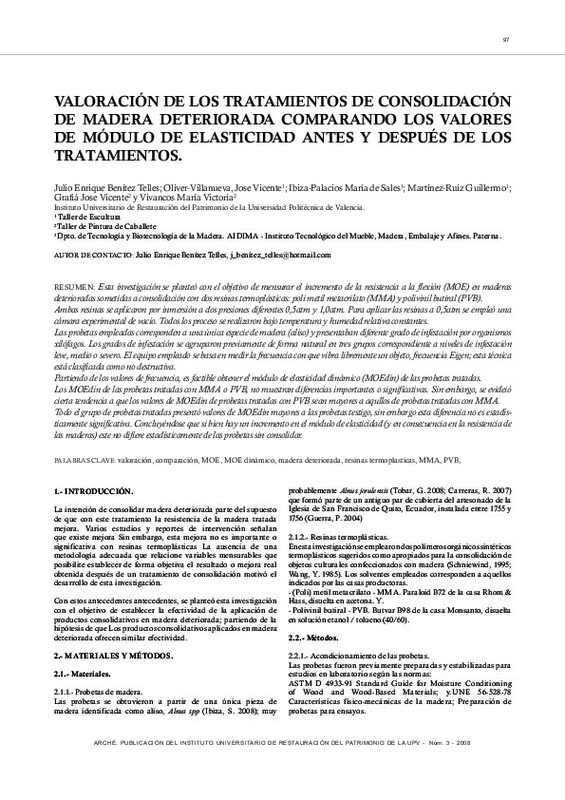JavaScript is disabled for your browser. Some features of this site may not work without it.
Buscar en RiuNet
Listar
Mi cuenta
Estadísticas
Ayuda RiuNet
Admin. UPV
Valoración de los tratamientos de consolidación de madera deteriorada comparando los valores de módulo de elasticidad antes y después de los tratamientos
Mostrar el registro sencillo del ítem
Ficheros en el ítem
| dc.contributor.author | Benítez Telles, Julio Enrique
|
es_ES |
| dc.contributor.author | Oliver Villanueva, José Vicente
|
es_ES |
| dc.contributor.author | Ibiza Palacios, María de Sales
|
es_ES |
| dc.contributor.author | Martínez Ruiz, Guillermo
|
es_ES |
| dc.contributor.author | Grafiá Sales, José Vicente
|
es_ES |
| dc.contributor.author | Vivancos Ramón, María Victoria
|
es_ES |
| dc.date.accessioned | 2013-09-04T10:37:17Z | |
| dc.date.available | 2013-09-04T10:37:17Z | |
| dc.date.issued | 2008 | |
| dc.identifier.issn | 1887-3960 | |
| dc.identifier.uri | http://hdl.handle.net/10251/31754 | |
| dc.description.abstract | Esta investigación se planteó con el objetivo de mensurar el incremento de la resistencia a la flexión (MOE) en maderas deterioradas sometidas a consolidación con dos resinas termoplásticas: poli metil metacrilato (MMA) y polivinil butiral (PVB). Ambas resinas se aplicaron por inmersión a dos presiones diferentes 0,5atm y 1,0atm. Para aplicar las resinas a 0,5atm se empleó una cámara experimental de vacío. Todos los procesos se realizaron bajo temperatura y humedad relativa constantes. Las probetas empleadas corresponden a una única especie de madera (aliso) y presentaban diferente grado de infestación por organismos xilófagos. Los grados de infestación se agruparon previamente de forma natural en tres grupos correspondiente a niveles de infestación leve, medio o severo. El equipo empleado se basa en medir la frecuencia con que vibra libremente un objeto, frecuencia Eigen; esta técnica está clasificada como no destructiva. Partiendo de los valores de frecuencia, es factible obtener el módulo de elasticidad dinámico (MOEdin) de las probetas tratadas. Los MOEdin de las probetas tratadas con MMA o PVB, no muestran diferencias importantes o significativas. Sin embargo, se evideió cierta tendencia a que los valores de MOEdin de probetas tratadas con PVB sean mayores a aquellos de probetas tratadas con MMA. Todo el grupo de probetas tratadas presentó valores de MOEdin mayores a las probetas testigo, sin embargo esta diferencia no es estadísticamente significativa. Concluyéndose que si bien hay un incremento en el módulo de elasticidad (y en consecuencia en la resistencia de las maderas) este no difiere estadísticamente de las probetas sin consolidar. | es_ES |
| dc.description.abstract | This study aims to measure the increase of the resistance of the flexion (MOE) in deteriorated wood subjected to consolidation with two thermoplastic resins: poly methyl methacrylate (MMA) and polyvinylbutyral (PVB). Both resins are applied for the immersion of two different pressures 0, 5 atm and 1, 0 atm. In order to apply the resins to 0, 5 atm a vacuum experimental camera is used. All the processes are established at relative constant temperature and humidity. The beakers used correspond to a unique type of wood (alder) and represent a different grade of infestation from woodworm. The grades of infestation are previously grouped in a natural way with three groups referring to the level of infestation: light, medium and severe. The working equipment is based on the measuring the frequency involving a freely vibrating object - the frequency Eigen. This technique is classified as not being destructive. Starting with the frequency values, it is feasible to obtain the module of dynamic elasticity (MOE din) from the treated beakers. The MOE din from the treated beakers with MMA or PVB do not show considerable nor important differences. However, a certain tendency is noticed that the MOE din values from the beakers treated with PVB tend to be higher than those treated with MMA. The whole group of treated beakers showed higher MOE din values than the other beakers, but the difference noted is not statistically significant. To sum up, even if there is an increase in the amount of elasticity (and as a consequence in the resistance of the wood), this does not differ statistically to the beakers that have not been consolidated. | es_ES |
| dc.format.extent | 6 | es_ES |
| dc.language | Español | es_ES |
| dc.publisher | Instituto Universitario de Restauración del Patrimonio de la UPV | es_ES |
| dc.relation.ispartof | Arché | es_ES |
| dc.rights | Reserva de todos los derechos | es_ES |
| dc.subject | Valoración | es_ES |
| dc.subject | Comparación | es_ES |
| dc.subject | MOE | es_ES |
| dc.subject | MOE dinámico | es_ES |
| dc.subject | Madera deteriorada | es_ES |
| dc.subject | Resinas termoplasticas | es_ES |
| dc.subject | MMA | es_ES |
| dc.subject | PVB | es_ES |
| dc.subject.classification | CONSERVACION Y RESTAURACION DE BIENES CULTURALES (UPV) | es_ES |
| dc.title | Valoración de los tratamientos de consolidación de madera deteriorada comparando los valores de módulo de elasticidad antes y después de los tratamientos | es_ES |
| dc.title.alternative | Valuation of the Treatments of Consolidation of Wood Deterioration Comparing the Values of the Elasticity Amounts Before and After the Treatment | es_ES |
| dc.type | Artículo | es_ES |
| dc.rights.accessRights | Abierto | es_ES |
| dc.contributor.affiliation | Universitat Politècnica de València. Instituto Universitario de Restauración del Patrimonio - Institut Universitari de Restauració del Patrimoni | es_ES |
| dc.description.bibliographicCitation | Benítez Telles, JE.; Oliver Villanueva, JV.; Ibiza Palacios, MDS.; Martínez Ruiz, G.; Grafiá Sales, JV.; Vivancos Ramón, MV. (2008). Valoración de los tratamientos de consolidación de madera deteriorada comparando los valores de módulo de elasticidad antes y después de los tratamientos. Arché. (3):97-102. http://hdl.handle.net/10251/31754 | es_ES |
| dc.description.upvformatpinicio | 97 | es_ES |
| dc.description.upvformatpfin | 102 | es_ES |
| dc.description.issue | 3 | |
| dc.identifier.eissn | 2445-1150 |
Este ítem aparece en la(s) siguiente(s) colección(ones)
-
Arché - Nº 03 : 2008 [45]






